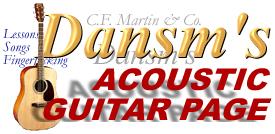
Strumming Patterns for Guitar
It seems that one of the most difficult techniques for beginners to grasp is coming up with
a decent strumming pattern to play the chords to a song. I get frequent e-mails
asking about the strumming pattern to a song. And I always tell them two things:
either listen to the recording or work one out yourself. This page is designed so you
will be able to work one out for yourself, after I give you a few basic ideas.
I am going to give you an initial strumming exercise,
then ten examples of possible strumming patterns, along with
RealAudio files of those same patterns so you can hear
what they sound like. I hope this page is useful to all who wonder
about strumming! Good luck, and if you have any questions, please
e-mail me!
First, you will need a little background information. The notation I use will
be standard musical notes on a single-line staff, so all you need to know is the rhythm.
If you don't understand the following quick example, you should check out
my notation page on meter and note values.

For the RealAudio files I will use, you will need the RealAudio Player,
which can be downloaded free from
www.real.com.
All RealAudio files contain the chord progression G-C-D-G.
To save the files for later use, right-click on the
desired link and choose "Save File As..." All RealAudio files are approximately
48K.
Strumming Exercise #1
Now a word about strumming. It is much easier and more efficient to strum in both directions:
up and down. The first exercise will teach you to strum in both directions.
Basically, all you do after doing this exercise is learn not to strum on
certain beats (you simply let the strings ring). The arrows in the diagram
below tell you whether to strum up or down. This up-and-down
movement is the key to the rest of the patterns, so practice it.
Here is the pattern:
 |
 |
RealAudio Stream for Exercise 1
All right, now it's time to move on to some strumming patterns. We will start with some really simple ones and work up to some more complicated ones. It is up to you to decide which of these patterns will sound good with what songs. After this, you should also be able to invent your own patterns. A little practice should make this easy. After these exercises, you will never again look at a piece of music and say "How do I strum?" Good luck!
Strumming Pattern #1
The first strumming pattern we will look at goes like this:
 |
 |
RealAudio Stream for Pattern 1
Strumming Pattern #2
This is a small variation of the first pattern:
 |
 |
RealAudio Stream for Pattern 2
Strumming Pattern #3
Here we add a tie for more interest:
 |
 |
RealAudio Stream for Pattern 3
Strumming Pattern #4
Move the tie, and it sounds totally different:
 |
 |
RealAudio Stream for Pattern 4
Strumming Pattern #5
Add another tie, for a more interesting rhythm:
 |
 |
RealAudio Stream for Pattern 5
Strumming Pattern #6
Of course we can remove one tie and get this:
 |
 |
RealAudio Stream for Pattern 6
Strumming Pattern #7
Move the tie again, to hear something a little different:
 |
 |
RealAudio Stream for Pattern 7
Strumming Pattern #8
If you add some longer notes, you get this:
 |
 |
RealAudio Stream for Pattern 8
Strumming Pattern #9
Just in case you thought we were getting too complicated (this is a variation of Pattern 3):
 |
 |
RealAudio Stream for Pattern 9
Strumming Pattern #10
The last pattern is a good one for slow songs:
 |
 |
RealAudio Stream for Pattern 10
That's it for now. I hope I have given you enough ideas to come up with patterns on your own. If you can't figure out how something should sound, make sure you listen to the RealAudio file, because it will tell you. Please tell me if this page has helped you! Use the files, the images, and my page on meter and note values and I promise you will have no trouble strumming again! Good luck, and have fun!
Back to Dansm's Acoustic Guitar Basics
You are visitor number
© 1997 Daniel E. Smith. Last updated 8-1-97